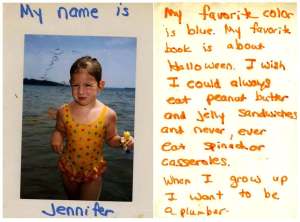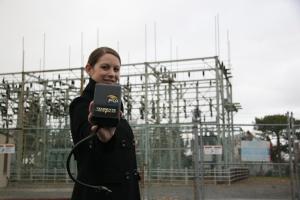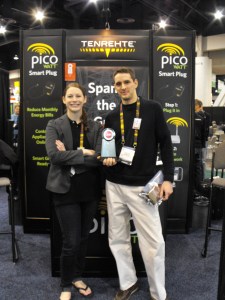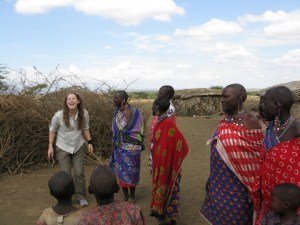Interactive Fellows Friday Feature!
Join the conversation by answering Fellows’ weekly questions via Facebook. This week, Jen asks:
“Most people think energy efficiency is boring. Besides an iPhone or Facebook app, how else can we show the playful side of energy efficiency?”
Click here to respond!
As a kid, what did you want to be when you grew up?
A plumber. What can I say? I like to fix problems. I have a picture of me at the beach in a polka dot swimsuit holding a PEZ dispenser. Below it my teacher wrote, “My name is Jennifer. My favorite color is blue. I want to be a plumber when I grow up.”
I’ve unclogged a few sinks in my time.
What a metaphor — now you’re fixing the clogged drains of the energy system.
[Laughs] That’s right.
Tell us about your company, Tenrehte.
Tenrehte (pronounced TEN-rate) is “Ethernet” spelled backwards. We decided to call it that because the whole crux of the company is to rethink new applications for wireless technology and Internet connectivity.
When I graduated from college, I was working for a Chinese semiconductor company. It required me to travel to China and train salespeople in mobile Internet television. To make a long story short, they eventually outsourced my job to China, so I decided to start Tenrehte.
I began brainstorming with some people I had been working with at that semiconductor company. We came up with three ideas for what we could be doing. One was patient-medical technology, where doctors could monitor patients from the Internet, from their cell phones. The other idea was Internet in everything. That was kind of my crazy, abstract idea. Let’s put Internet in your TV, your refrigerator, everything. Maybe your TV is watching Food Network, and your TV tells your fridge, “Jen just watched Food Network, she’s going to want salmon tonight, so fridge, make sure the salmon’s thoroughly thawed and ready for Jen to cook it.
And the third idea was green technology: energy management, energy efficiency. So our team started making prototypes, and one of the prototypes was an outlet adapter that could communicate with the Internet. From your smartphone, you could tell the outlet to shut on and off devices from anywhere in the world. So if you’re traveling, and you can’t remember if you turned off your light, you could turn it off.
We called the product the PICOwattTM. It’s an outlet-based device, which means it’s retrofit, so you don’t have to rip open your whole house or whole office just to make your appliances smart. We thought it was a very fundamental, simple solution.
We need some simple solutions. I don’t know about you, but I am over stimulated.
Why do you call it “PICOwatt”?
PICO stands for Portable Intelligent Communicator – portraying a sense of a vision for the future of sensors. The “watt” part of the name reminds us that solutions need to be practical, with applications for affecting change now.
What made your product really take off?
I heard about a competition associated with the Consumer Electronics Show, called iStage — a showroom for prototype technologies. So we entered in our outlet adapter, the PICOwattTM Smart Plug.
We were selected as a finalist for iStage, and our product really resonated with people. When I held up my iPhone and pressed “On,” the light turned on. I pressed “Off” and the light turned off. That simple moment had a big impact.
We didn’t win the iStage competition, but they gave us a booth at the Consumer Electronics Show anyway. With my background in marketing, I lined up a ton of media interviews. That was great — we had C-NET, Fox Business News, and we had the BBC cover us … it was amazing. We were up against 5,000 incredible competitors — including the likes of Google — and we ended up winning Best of CES Green Product of the Year.
I think we won because we were doing something revolutionary to Smart Grid and energy when nobody was really talking about it.
Our product simplifies control for energy consumers, as opposed to restricting them or trying to make them feel guilty. We are the only ones saying, “We’re human. We use power. We’re going to continue to use power.”
We can’t just assume that people care about managing their own energy. We have to give them tools that are really simple, and also fun and interesting for them.
What’s the company’s latest big news?
Right now we’re in the process of making sales to corporate customers, governments, and institutions. They are trying to understand the energy use of buildings, and understand how energy efficiency really is the catalyst for the green movement. Without saving energy, we will never get to the point of being 100% renewable. We just don’t have the infrastructure to support full solar, full wind, off-grid, without energy efficiency.
One of the big concerns are blackouts. In countries such as South Africa blackouts can be life threatening and more expensive to fix. Because PICOwattTM is Internet-enabled, it can give a real-time alert of an outage or peak power usage.
In the US, I get a lot of flack for doing retrofit because it’s “ugly.” But outside of the US, there isn’t such a tendency to throw out a new TV and buy a new one because it’s two inches bigger! And a quarter less power usage! For countries where people don’t need the latest and greatest, retrofit is a desirable option. If we can provide customers a way to make the things they already own save energy, to them, that’s the true definition of green.
Tell us about your ecotourism experiences in Kenya. How did you help improve energy efficiency there?
I took an ecotourism safari with my family in 2008, all around Kenya. It really was an eye-opener for me in terms of energy. Globally, everyone is talking about green energy generation: wind, solar, tidal, underwater tidal, space wind energy, space solar energy, biofuels, spent uranium rods, terra energy. But in Kenya, I found some interesting things that we can change, right now, with the technology we already have.
I do thoroughly believe that the change that happens in Africa is going to come from local solutions to local problems. For instance, we visited a Maasai village and they had solar platforms that they were using to generate power.
The problem was, the batteries they had for storage of their solar power were sitting on a slab of concrete in a hut. And it gets really hot in huts. By suggesting that they dig a ditch and bury the batteries, to keep them at a moderate temperature, the batteries would not melt.
It sounds simple, but what it shows is that sometimes you don’t need a really expensive, fancy technology to make what you already have more efficient, just look around you. Sometimes a six-inch ditch means you don’t need to build another windmill. I believe that idea is just as true in Mombasa as it is in Rochester.
I have seen villages in Kenya that are running off of solar thermal water heating for the whole village and solar power for their schools. They are far better than us here in the West on this. Our infrastructure in the West is maybe a bit over developed. It really isn’t friendly to off-grid integration, yet.
How have you shared your experiences from abroad back home?
Well, I was invited by some teachers to present in the inner city schools here in Rochester. I made a conservationist video and I brought it in to show the kids. I gave them a glimpse of a life that they never see or hear about.
I’m big into animal rights, so I showed them the conservation techniques that exist in Kenya and how they do so well to try to mitigate poaching, to see animals as natural resources, which are worth more alive than dead.
At the end, the kids had the opportunity to write notes. They wrote things like, “That woman is crazy.”
“I can’t believe she got so close to a lion.”
“Was she nuts?”
The kids saw something they wouldn’t have seen otherwise, and they were exposed to a new culture. Any real world experience that you can share, kids will metabolize it so much better.
What did the TED Fellowship mean to you?
People say I’m very positive. You know, “Jen’s a force of nature.” And that I have so much energy, it’s like you’re talking to caffeine. But, at the same time, I think we’re all vulnerable to our own vision. [Laughs] That sounded so cheesy!
We all have our own ideas. But when we put our ideas out there, we’re vulnerable to negative feedback that isn’t constructive.
Sometimes you need support from people who understand what you’re trying to do, you need to hear that you’re doing the right thing. And not from your mother.
There are many aspiring social entrepreneurs out there who are trying to take their passion and ideas to the next level. What is one piece of advice you would give to them based on your own experiences and successes? Learn more about how to become a great social entrepreneur from all of the TED Fellows on the Case Foundation blog.
Don’t take yourself too seriously. Have fun, you know? I think social entrepreneurs really carry a lot of weight and gravity around with them.
I do it sometimes. I catch myself going, “I’m changing the way the world consumes energy. Dun-dun-dunnnn!” And then I have to remind myself, “Jennifer, you’re ridiculous, get back to work. Relax.”
If you’re doing what you love, you’re going to be good at it, no matter what. If you’re a social entrepreneur and you’re doing your thing, you already know to follow your passion, you know you have to find meaningful partners, and you know you need to ignore naysayers.
So just remember not to take yourself too seriously.





Comments (8)
Pingback: The TED Fellows 2014 holiday gift guide | TEDFellows Blog
Pingback: TEDxFlourCity « Art With Ms. B